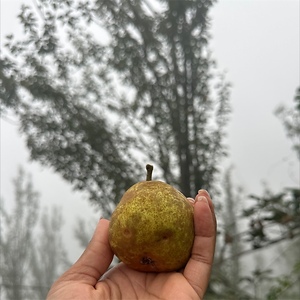


Nakh Pears
Estimated Inventory, lb : 0
Description/Taste
Nakh pears may have a round, globular, conical, and squat shape or an oval shape with a bulbous base that tapers into a rounded neck. Their firm skin can be golden yellow, light green, or bronze and is covered in visible lenticels or pores, possessing some russeting along their skin. Nakh pear flesh has an ivory hue and a crunchy, juicy, and creamy texture with a central fibrous core encasing several small, brown-black seeds. When ripe, Nakh pears are crisp and sweet with a floral flavor, low acidity, and refreshing bite.
Seasons/Availability
Nakh pears are available from late summer to winter.
Current Facts
Nakh pears are botanically classified as Pyrus pyrifolia and are members of the Rosaceae family along with apples, peaches, pears, apricots, plums, and cherries. This variety is known by many different names including the Chinese Sand pear, Apple pear, Patharnakh, and Gola pear. They are one of the many common pear varieties grown in India along with Nashpati, Babugosha, Patharnakh, and Punjab Nakh. These types of pears grow in many different areas within the country, most predominantly in Himachal Pradesh, Jammu, and Kashmir. Nakh pears are favored for their crisp, juicy flesh and are mainly used as fresh fruit. Unlike regular pears, this variety ripens on the tree and is only picked and sold at this point.
Nutritional Value
Nakh pears are a good source of vitamin C, an antioxidant that bolsters the immune system, promotes skin health, and aids in iron absorption, while vitamin K plays a crucial role in blood clotting and bone metabolism. Additionally, Nakh pears contribute to your intake of folate, vital for DNA synthesis and red blood cell formation, and potassium, which helps maintain healthy blood pressure and supports muscle and nerve function. These pears also contain copper, a trace mineral essential for iron absorption and connective tissue health. Notably, the peel of Nakh pears is rich in quercetin, a powerful flavonoid with antioxidant properties that may reduce inflammation, lower the risk of chronic diseases, and support cardiovascular health.
Applications
Nakh pears are best suited for raw applications and are often enjoyed fresh, as their flesh can brown when sliced. This variety is commonly added to green salads, cubed for fruit bowls, featured on cheese boards alongside other fruits and nuts, grated into coleslaw, or sliced for stir-fries. They can also be chopped and incorporated into holiday stuffing, sautéed with cinnamon to top pork chops, slow-cooked to create a sweet sauce for short ribs, or served in mulled white wine or a warm pear toddy. Additionally, Nakh pears can be hollowed out and filled with dried fruit and nuts for a baked treat. Their sweet flavor and juiciness enhance cakes, pies, crisps, puddings, muffins, and quick breads. They can be canned or preserved for later use while maintaining their shape. Nakh pears pair well with cashews, blue cheese, manchego cheese, red onion, scallions, garlic, leafy greens, celery, fennel, sweet potatoes, salmon, lime, blackberries, raisins, nut butter, honey, sesame oil, shiso, miso, and daikon. When stored at room temperature, they will keep for 10 to 14 days and up to three months in the refrigerator.
Ethnic/Cultural Info
Kashmir's Mughal royal gardens are celebrated for their lush orchards filled with peach, pear, plum, and cherry trees, complemented by fountains that spout refreshing, icy water. Before the spread of Islam, Kashmir was largely a Hindu region, where the idea of pleasure gardens was already established. Influenced by ancient India's vatikas, or wooded pleasure gardens, a variety of orchards were developed in the valley. These lush areas flourished with diverse flowers, herbs, and aromatic plants, and many ancient myths and plays feature events set in these vatikas. One of the earliest gardens in Hindu Kashmir was the Bagh-i-Tut, or Mulberry Garden, a grove of mulberry trees created by a Hindu saint named Maya Swami, located near what is now the Maisuma area.
Geography/History
Nakh pears are native to Japan and China, where they have been grown for over 3,000 years but have since been naturalized to the Punjab region of northern India. They thrive in temperate and subtropical climates, requiring low chilling hours for proper growth. This variety first spread from its native countries to the Himalayan regions of India and other parts of Asia by way of merchants and traders. In the mid-1800s, Nakh pears made their way to the United States through Chinese and Japanese immigrants. Beginning in the 1950s, they gained popularity as a commercial crop in India, with an estimated 5,000 hectares of land designated for their cultivation in Punjab. Today, Nakh pears can be found at farmers' markets and specialty grocers in Asia, Southeast Asia, Europe, Australia, New Zealand, the United States, and Canada.
Recipe Ideas
Recipes that include Nakh Pears. One
Podcasts








